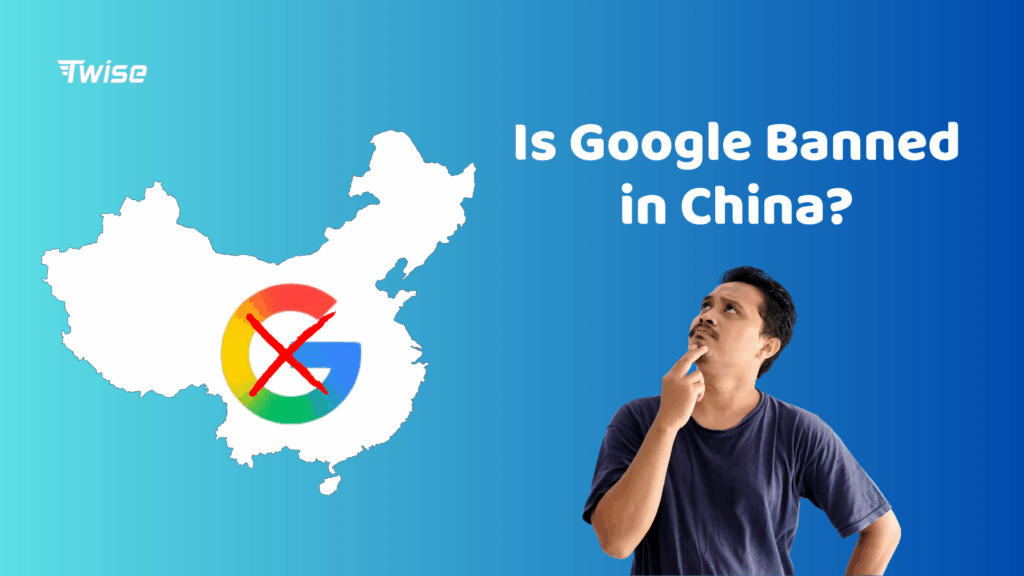Google in China: Is It Banned and How to Use It?
Many travelers and expats are surprised to learn that Google in China doesn’t work the same way it does elsewhere. Most Google services – including Search, Gmail, Maps, and YouTube – are blocked by the Great Firewall of China. However, there are still safe and legal ways to access Google tools while you’re in the country. In this guide, we’ll explain why Google is banned in China and share practical tips on how to use it effectively during your stay.
What Is the Great Firewall of China and How Does It Work?
The Great Firewall of China is the world’s most advanced internet censorship system. It acts like a digital filter between users in China and the global internet, deciding what is allowed and what is blocked.
It doesn’t just block social media – it restricts key apps like Google, WhatsApp, Slack, Facebook, Instagram, Twitter, Teams, and even many VPN websites.
What makes it powerful is its use of Deep Packet Inspection (DPI). Instead of only blocking website URLs, it analyzes your internet traffic. This allows it to detect and stop VPNs and adapt quickly, so a workaround that works today may stop working tomorrow.
Full List of Google Services Blocked in China (2025 Update)
Let’s be blunt – Google simply doesn’t work in mainland China. The Great Firewall blocks every major Google platform, including:
- Gmail & Google Search
- Google Maps & Google Drive
- YouTube & Google Photos
- Google Docs, Sheets, and the entire Workspace suite
Even Google.com.hk (Hong Kong) is no longer a reliable workaround. Search results are heavily filtered, making it practically useless.
Why?
Since Google refused China’s censorship demands in 2010, the government has shut the door on all Google services – no partial access, no local alternatives, no exceptions.
Why Does China Block Google? The Real Reasons Explained
The 2010 Google – China fallout was nothing short of a tech-world drama.
When Chinese authorities demanded that Google censor search results, Google refused and shifted its operations to Hong Kong.
Then things escalated – Google revealed that state-linked hackers had tried to access the Gmail accounts of Chinese activists. That was the breaking point.
From that moment on, the Great Firewall slammed shut.
All Google services were treated like unwanted intruders and were permanently blocked.
What began as a clash over censorship has turned into a long-term digital divide – one that forces millions in China to use workarounds just to access the world’s most-used search engine.
The Risks of Using a VPN in China: What Travelers Should Know
Relying on a VPN in China can quickly turn into a productivity nightmare.
- Speeds often crawl to a halt, especially during peak hours when millions are online. Even checking email can take minutes.
- Connections randomly drop, sometimes right before critical calls or client presentations.
- Unreliable performance forces travelers to buy multiple VPN subscriptions, spending $30–50 per month per VPN just to have backups.
- You still need a local Chinese data plan to even use a VPN, creating a double-cost situation that adds up fast – especially on long trips.
eSIM vs VPN in China: Why eSIMs Are the Smarter Option
eSIMs don’t rely on Chinese internet infrastructure – they route your traffic through international networks.
That means:
- Google, Gmail, Maps, YouTube, Slack, WhatsApp – all work instantly the moment you land. No apps to install. No connection tricks.
- Most “blocked” sites stay accessible because your data never touches domestic Chinese filtering systems.
- Rock-solid reliability, crucial when working across time zones or during important calls, meetings, or file transfers.
- Fully legal and compliant. eSIMs use official international roaming agreements — not loopholes. Even Chinese authorities recognize them.
- No speed throttling. You get consistently faster data, perfect for video conferencing and large uploads.
Step-by-Step: How to Use an eSIM to Access Google in China
Step 1: Buy Before You Fly
Go to Twise’s website and choose either a China eSIM or a regional Asia plan.
Complete the purchase and save the confirmation email (includes QR code + setup instructions).
Step 2: Install the eSIM
On iOS:
Settings → Cellular → Add eSIM → Scan QR code → Label it (e.g. “Twise China”)
On Android:
Settings → Network & Internet → SIMs → Add SIM → Scan QR or enter code manually → Label it.
(Path may vary by device)
Step 3: Activate After Landing
Go to Settings and set the Twise eSIM as the active mobile data line.
Enable Data Roaming if asked.
Wait a few minutes – it should connect automatically.
Step 4: Test Google Access
Open Google Maps, Gmail, YouTube, etc.
Because the eSIM uses international routing, Google and other blocked apps will work normally.
Step 5: If Something Isn’t Working
- Restart your phone
- Ensure Mobile Data + Data Roaming are ON
- Make sure Twise eSIM is set as the primary data line
- Turn off any VPNs or proxy settings
Still stuck? Open the Twise website for troubleshooting or contact their support.
Stay Connected Anywhere with eSIM: From China to the World
China’s Great Firewall blocks Google, Gmail, Maps, YouTube, WhatsApp, and countless essential apps. If you rely on these tools, staying connected isn’t optional – it’s critical.
That’s where the Twise China eSIM comes in.
It lets you bypass the Great Firewall instantly, without slow VPNs, risky workarounds, or complicated setups.
- Full access to Google & global apps
- Fast, stable data for work and travel
- No software, no configuration, no legal worries
Whether you’re working remotely, exploring new cities, or staying in touch with family, a country-specific or regional eSIM keeps your internet fast, secure, and reliable from the moment you land.
Read more: WhatsApp in China: Can You Access It and How?

